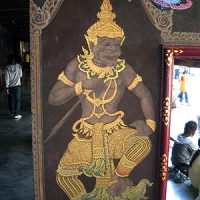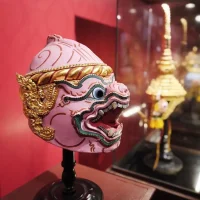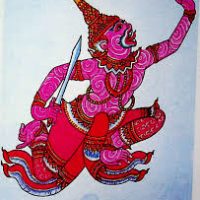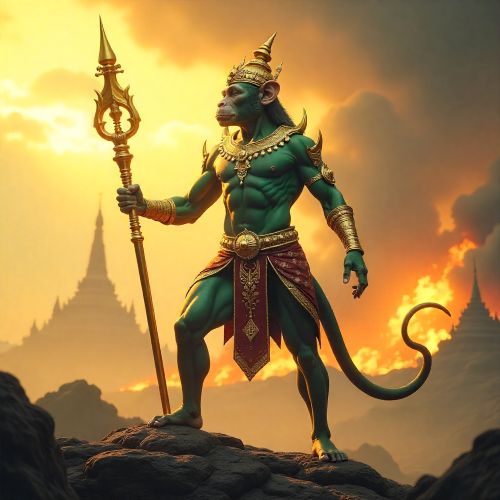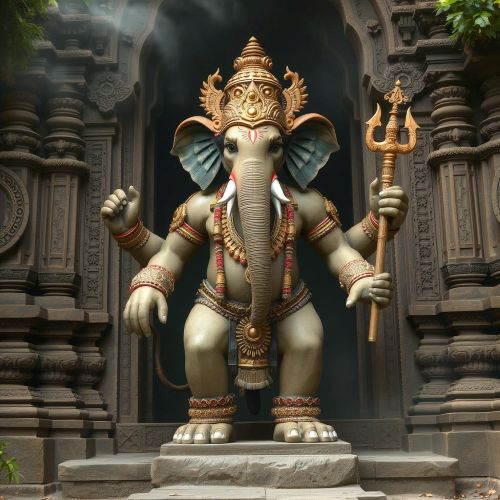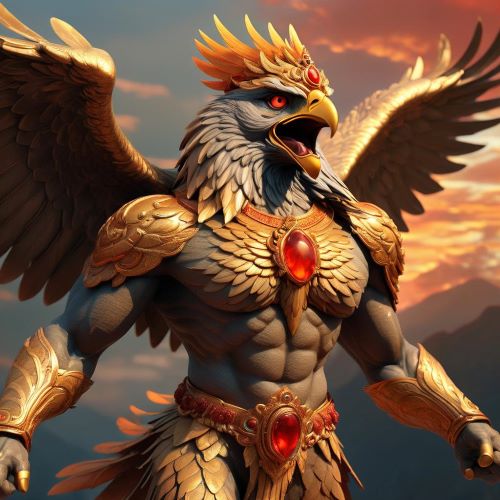Chomphuphan : The Divine Healer and Monkey Warrior of the Ramakien
Listen
At a glance
| Description | |
|---|---|
| Origin | Thai Mythology |
| Classification | Hybrids |
| Family Members | N/A |
| Region | Thailand |
| Associated With | Warrior, Wisdom, Healing |
Chomphuphan
Introduction
Chomphuphan (Thai: ชมพูพาน) stands as one of the most intriguing characters in Thailand’s Ramakien, the national epic derived from the Indian Ramayana. Though often overshadowed by Hanuman, Chomphuphan’s importance lies in his dual role as a healer and a strategist, balancing intellect and bravery within the army of Phra Ram (Rama). Revered for his compassion, medical mastery, and loyalty, Chomphuphan embodies the spiritual and moral values central to Thai mythology. His story bridges divine wisdom with heroic duty, making him not just a warrior, but a symbol of healing and protection in Thai cultural heritage.
Physical Traits
In traditional Thai art and khon (masked dance-drama) performances, Chomphuphan is depicted as a vanara—a divine monkey being—with a distinctive pinkish hue to his skin, setting him apart from the white-furred Hanuman and the darker-toned Sugriva. His color represents vitality, love, and purity, aligning with his role as a healer. Chomphuphan is often adorned in elaborate golden armor with intricate motifs that reflect his celestial origins. He wears a chadah-style crown known as the Jaya Mukuta, reserved for royal beings and divine generals, with its slightly bent tip symbolizing humility despite his power. His graceful yet powerful stance in temple murals conveys both martial skill and spiritual composure, capturing the essence of a warrior guided by wisdom.
Family
According to the Ramakien, Chomphuphan was born from the divine essence of Phra Isuan (Shiva), who created several monkey warriors to aid Phra Ram in his battle against the demon king Thotsakan (Ravana). This divine origin connects Chomphuphan directly to the heavens, granting him supernatural abilities and insight. He is later adopted by Phali, another monkey king, which cements his noble status among the vanara. His close kinship with figures like Hanuman and Onkhot strengthens the unity of the monkey army and reinforces themes of divine cooperation and loyalty. Within this sacred hierarchy, Chomphuphan’s wisdom and healing serve as essential counterbalances to the sheer might and aggression of his peers.
Other names
In Thai retellings, Chomphuphan is occasionally equated with or inspired by Jambavan from the Ramayana, though his depiction diverges significantly in Southeast Asian contexts. The name “Chomphuphan” itself combines Chomphu (ชมพู), meaning “pink” or “rose apple,” with Phan (พาน), referring to a ceremonial tray—suggesting offerings, divinity, and reverence. This etymology emphasizes both his gentle demeanor and his spiritual importance. In some local adaptations, he is affectionately referred to as Phra Chomphuphan, highlighting his semi-divine nature and his role as a respected leader among the vanara ranks. These names underscore how his image has evolved while maintaining his symbolic connection to healing and celestial order.
Powers and Abilities
Chomphuphan’s most celebrated ability is his mastery of healing arts. Taught directly by Phra Isuan, he became the chief physician of Phra Ram’s army, known for his deep understanding of mystical herbs and divine remedies. One of his most famous deeds involves identifying the life-saving herb needed to heal Phra Lak (Lakshman) after he was struck down by the demon general Intharachit’s enchanted arrow. The herb was said to grow on Mount Awut in the enchanted land of Buppha Phawi, a place guarded by a spinning celestial disc. Chomphuphan’s guidance and wisdom enabled Hanuman to retrieve the herb, thus saving the wounded warriors—a moment that showcases intellect triumphing over brute force.
Beyond his healing gifts, Chomphuphan is also a capable warrior and tactician. He commands troops with precision, opening battles and coordinating attacks alongside Hanuman and Phali. His supernatural agility, immense strength, and ability to expand or shrink his size at will make him a versatile combatant. Unlike many warriors who seek glory, Chomphuphan’s power serves the collective—he fights to protect, heal, and restore balance rather than to dominate. This fusion of might and mindfulness defines his role as one of the most spiritually balanced figures in Thai mythology.
Modern Day Influence
Today, Chomphuphan continues to inspire artists, performers, and cultural historians across Thailand. His likeness appears in khon performances and temple murals, particularly in the grand depictions of the Ramakien at Wat Phra Kaew (Temple of the Emerald Buddha) in Bangkok. His pink and gold figure, often shown offering herbs or leading troops, remains a symbol of knowledge and devotion.
In contemporary Thailand, Chomphuphan’s image has found new life in animation, graphic novels, and cultural education projects aimed at preserving traditional mythology. He has become a metaphor for modern values—wisdom in leadership, compassion in service, and courage tempered by intellect. Some Thai wellness traditions and cultural programs even invoke his spirit as a patron of healers and protectors. Through evolving artistic expressions, Chomphuphan bridges the ancient and the modern, embodying Thailand’s enduring respect for balance between body, mind, and spirit.
Related Images
Source
Shastri, S. V. (n.d.). Ramayana in Southeast Asia: Ramakien Characters. Wisdom Library. https://wisdomlib.org/hinduism/book/ramayana-of-valmiki/d/doc423874.html
ThailandBlog. (2022, October 28). The Ramakien: The Thai national epic with Indian roots. https://thailandblog.nl/2022/10/28/the-ramakien-the-thai-national-epic-with-indian-roots/
Poets.org. (2024, May 19). Ramakien, “Hanuman Carries the Mountain to Cure Phra…”. https://poets.org/poem/ramakien-hanuman-carries-mountain-cure-phra
Wikipedia contributors. (2024, June 11). Category: Thai mythology. Wikipedia. https://en.wikipedia.org/wiki/Category:Thai_mythology
Explore Bangkok. (2025, June 19). Mythical creatures of Thailand. https://explore-bangkok.com/mythical-creatures-of-thailand
Sarpublication.com. (n.d.). From Nāri-lāta to Nariphon: Examining the Iconographic Production from Ancient Buddhist Texts. https://sarpublication.com/upload/2021-986.pdf
PMC. (2022, May 31). Local Wisdom and Diversity of Medicinal Plants in Chaing Rai. https://www.ncbi.nlm.nih.gov/pmc/articles/PMC9183088/
Archive.lib.cmu.ac.th. (n.d.). Chapter 2. Retrieved from https://archive.lib.cmu.ac.th/handle/123456789/1234
Bhumibol, A. (1999). Ramakien: The Thai Ramayana. River Books.
Brandon, J. R. (1967). Theatre in Southeast Asia. Harvard University Press.
Terwiel, B. J. (2011). Thailand’s Political History: From the Fall of Ayutthaya to Recent Times. River Books.
Mair, V. H. (Ed.). (2005). The Columbia History of Chinese Literature. Columbia University Press.
Winichakul, T. (1994). Siam Mapped: A History of the Geo-Body of a Nation. University of Hawaii Press.
Frequently Asked Questions
Who is Chomphuphan in Thai mythology?
Chomphuphan is a divine monkey warrior and healer in Thailand’s Ramakien, serving under Phra Ram. He is revered for his wisdom, loyalty, and healing powers granted by the god Phra Isuan.
What are Chomphuphan’s main abilities?
Chomphuphan is known for his mastery of healing magic, deep knowledge of herbs, and combat prowess. He also possesses supernatural agility and the power to change his size.
How is Chomphuphan different from Hanuman?
While Hanuman represents courage and devotion through action, Chomphuphan embodies wisdom, healing, and intellect, making them complementary forces within Phra Ram’s army.
Where can Chomphuphan be seen in Thailand today?
Depictions of Chomphuphan can be found in murals at Wat Phra Kaew in Bangkok, as well as in traditional khon performances and modern Thai art.
What does the name Chomphuphan mean?
“Chomphu” means pink or rose apple, while “Phan” refers to a ceremonial tray, symbolizing divinity and reverence—reflecting Chomphuphan’s noble and spiritual nature.



